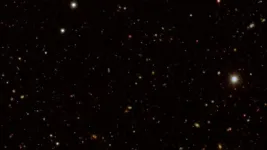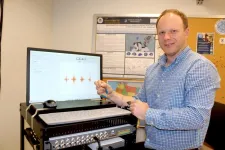(Press-News.org) In 1998, astrophysicists discovered that the universe is expanding at an accelerating rate, attributed to a mysterious entity called dark energy that makes up about 70% of our universe. While foreshadowed by earlier measurements, the discovery was somewhat of a surprise; at the time, astrophysicists agreed that the universe’s expansion should be slowing down because of gravity.
This revolutionary discovery, which astrophysicists achieved with observations of specific kinds of exploding stars, called type Ia (read “type one-A”) supernovae, was recognized with the Nobel Prize in Physics in 2011.
Now, 25 years after the initial discovery, the scientists working on the Dark Energy Survey have released the results of an unprecedented analysis using the same technique to further probe the mysteries of dark energy and the expansion of the universe. They placed the strongest constraints on the expansion of the universe ever obtained with the DES supernova survey.
In a presentation at the 243rd meeting of the American Astronomical Society on Jan. 8 and in a paper submitted to the Astrophysical Journal in January titled, "The Dark Energy Survey: Cosmology results with ~1500 new high-redshift type Ia supernovae using the full 5-year dataset,” DES astrophysicists report results that are consistent with the now-standard cosmological model of a universe with an accelerated expansion. Yet, the findings are not definitive enough to rule out a possibly more complex model.
Taking a unique approach to analysis
The Dark Energy Survey is an international collaboration comprising more than 400 astrophysicists, astronomers and cosmologists from over 25 institutions led by members from the U.S. Department of Energy’s Fermi National Accelerator Laboratory. DES mapped an area almost one-eighth the entire sky using the Dark Energy Camera, a 570-megapixel digital camera built by Fermilab and funded by the DOE Office of Science. It was mounted on the Víctor M. Blanco Telescope at the National Science Foundation’s Cerro Tololo Inter-American Observatory, a Program of NSF’s NOIRLab in 2012. DES scientists took data for 758 nights across six years.
To understand the nature of dark energy and measure the expansion rate of the universe, DES scientists perform analyses with four different techniques, including the supernova technique used in 1998.
This technique requires data from type Ia supernovae, which occur when an extremely dense dead star, known as a white dwarf, reaches a critical mass and explodes. Since the critical mass is nearly the same for all white dwarfs, all type Ia supernovae have approximately the same actual brightness and any remaining variations can be calibrated out. So, when astrophysicists compare the apparent brightnesses of two type Ia supernovae as seen from Earth, they can determine their relative distances from us.
Astrophysicists trace out the history of cosmic expansion with large samples of supernovae spanning a wide range of distances. For each supernova, they combine its distance with a measurement of its redshift — how quickly it is moving away from Earth due to the expansion of the universe. They can use that history to determine whether the dark energy density has remained constant or changed over time.
“As the universe expands, the matter density goes down,” said DES director and spokesperson Rich Kron, who is a Fermilab and University of Chicago scientist. “But if the dark energy density is a constant, that means the total proportion of dark energy must be increasing as the volume increases.”
The culmination of a decade of effort
The standard cosmological model is ΛCDM, or Lambda Cold Dark Matter, or Lambda Cold Dark Matter, a model based on the dark energy density being constant over cosmic time. It tells us how the universe evolves, using just a few features, such as the density of matter, type of matter and behavior of dark energy. The supernova method constrains two of these features very well: matter density and a quantity called w, which indicates whether the dark energy density is constant or not.
According to the standard cosmological model, the density of dark energy in the universe is constant, which means it doesn’t dilute as the universe expands. If this is true, the parameter represented by the letter w should equal –1.
When the DES collaboration internally unveiled their supernova results, it was a culmination of a decade’s worth of effort and an emotional time for many of the astrophysicists involved. “I was shaking,” said Tamara Davis, a professor at the University of Queensland in Australia and co-convener of DES’s supernova working group. “It was definitely an exciting moment.”
The results found w = –0.80 +/- 0.18 using supernovae alone. Combined with complementary data from the European Space Agency’s Planck telescope, w reaches –1 within the error bars.
“w is tantalizingly not exactly on –1, but close enough that it’s consistent with –1,” said Davis. “A more complex model might be needed. Dark energy may indeed vary with time.”
To come to a definitive conclusion, scientists will need more data. But DES won’t be able to provide that; the survey stopped taking data in January 2019. The supernova team, led by many Ph.D. students and postdoctoral fellows, will soon have extracted all they can from the DES observations.
“More than 30 people have been involved in this analysis, and it is the culmination of almost 10 years of work,” said Maria Vincenzi, a research fellow at Duke University who co-led the cosmological analysis of the DES supernova sample. “Some of us started working on this project when we were barely at the beginning of our Ph.D., and we are now starting faculty positions. So, the DES Collaboration contributed to the growth and professional development of an entire generation of cosmologists.”
Pioneering a new approach
This final DES supernova analysis made many improvements upon DES’s first supernova result released in 2018 that used just 207 supernovae and three years of data.
For the 2018 analysis, DES scientists combined data about the spectrum of each supernova to determine their redshifts and to classify them as type Ia or not. They then used images taken with different filters to identify the flux at the peak of the light curve — a method called photometry. But spectra are hard to acquire, requiring lots of observing time on the largest telescopes, which will be impractical for future dark energy surveys like the Legacy Survey of Space and Time, LSST, to be conducted at the Vera C. Rubin Observatory, operated jointly by NSF’s NOIRLab and DOE’s SLAC National Accelerator Laboratory.
The new study pioneers a new approach to use photometry — with an unprecedented four filters — to find the supernovae, classify them and measure their light curves. Follow-up spectroscopy of the host galaxy with the Anglo-Australian Telescope provided precise redshifts for every supernova. The use of the additional filters also enabled data that is more precise than previous surveys and is a major advancement compared to the Nobel-winning supernovae samples, which only used one or two filters.
DES researchers used advanced machine-learning techniques to aid in supernova classification. Among the data from about two million distant observed galaxies, DES found several thousand supernovae. Scientists ultimately used 1,499 type Ia supernovae with high-quality data, making it the largest, deepest supernova sample from a single telescope ever compiled. In 1998, the Nobel-winning astronomers used just 52 supernovae to determine that the universe is expanding at an accelerating rate. “It’s a really massive scale-up from 25 years ago,” said Davis.
There are minor drawbacks of the new photometric approach compared to spectroscopy: Since the supernovae do not have spectra, there is greater uncertainty in classification. However, the much larger sample size enabled by the photometric approach more than makes up for this.
The innovative techniques DES pioneered will shape and further drive future astrophysical analyses. Projects like Rubin’s LSST and NASA’s Nancy Grace Roman Space Telescope will pick up where DES left off. “We’re pioneering these techniques that will be directly beneficial for the next generation of supernova surveys,” said Kron.
“This new supernova result is exciting because this means we can really tie a bow on it and hand it out to the community and say, ‘This is our best attempt at explaining how the universe is working,’” said Dillon Brout, an assistant professor at Boston University who co-led the cosmological analysis of the DES Supernova sample with Vincenzi. “These constraints will now be the gold standard in supernova cosmology for quite some time.”
Even with more advanced dark energy experiments forthcoming, DES scientists emphasized the importance of having theoretical models to explain dark energy in addition to their experimental observations. “All of this is really unknown territory,” said Kron. “We do not have a theory that puts dark energy into a framework that relates to other physics that we do understand. For the time being, we in DES are working to constrain how dark energy works in practice with the expectation that, later on, some theories can be falsified.”
DES scientists continue to use the supernova results in more analyses by integrating them with results obtained with the other DES techniques. “Combining the DES supernova information with these other probes will even better inform our cosmological model,” said Davis.
“Even if we measure dark energy infinitely precisely, it doesn’t mean we know what it is,” she said. “Dark energy is still out there to be discovered.”
Funding for the DES Projects has been provided by the U.S. Department of Energy, the U.S. National Science Foundation, the Ministry of Science and Education of Spain, the Science and Technology Facilities Council of the United Kingdom, the Higher Education Funding Council for England, the National Center for Supercomputing Applications at the University of Illinois at Urbana-Champaign, the Kavli Institute of Cosmological Physics at the University of Chicago, Funding Authority for Funding and Projects in Brazil, Carlos Chagas Filho Foundation for Research Support of the State of Rio de Janeiro, Brazilian National Council for Scientific and Technological Development and the Ministry of Science and Technology, the German Research Foundation and the collaborating institutions in the Dark Energy Survey.
The U.S. National Science Foundation's National Optical-Infrared Astronomy Research Laboratory (NOIRLab) operates the Cerro Tololo Inter-American Observatory (CTIO) and Vera C. Rubin Observatory (operated in cooperation with the U.S. Department of Energy’s SLAC National Accelerator Laboratory). The research community is honored to have the opportunity to conduct research on Cerro Tololo and Cerro Pachón in Chile. We recognize and acknowledge the very significant cultural role and reverence that these sites have to the local communities in Chile.
Based in part on data acquired at the Anglo-Australian Telescope for the Dark Energy Survey by OzDES. We acknowledge the traditional custodians of the land on which the AAT stands, the Gamilaraay people, and pay our respects to elders past and present.
END
Final supernova results from Dark Energy Survey offer unique insights into the expansion of the universe
2024-01-08
ELSE PRESS RELEASES FROM THIS DATE:
Life span increases in mice when specific brain cells are activated
2024-01-08
In recent years, research has begun to reveal that the lines of communication between the body’s organs are key regulators of aging. When these lines are open, the body’s organs and systems work well together. But with age, communication lines deteriorate, and organs don’t get the molecular and electrical messages they need to function properly.
A new study from Washington University School of Medicine in St. Louis identifies, in mice, a critical communication pathway connecting the brain and the body’s fat tissue in a feedback loop ...
Robotic rehab aims to help stroke patients regain hand dexterity
2024-01-08
Every year, about 800,000 new stroke cases are reported in the United States, often causing patients problems with both neurological and physical motor control. Disruptions in the mobility of the arms and hands, in particular, can have devastating impacts on stroke patients’ quality of life.
The restoration of arm extremity and hand dexterity are often the highest priority among stroke patients. A new robotic platform developed at the University of Rhode Island, which utilizes both a patient’s brainwaves and muscle activity, aims to help post-stroke patients perform needed rehabilitation and regain critical motor skills, including complex tasks like reaching and grasping ...
Illinois Tech launches sensor technology program with emphasis on veteran education
2024-01-08
CHICAGO—January 8, 2023—Illinois Institute of Technology (Illinois Tech) has received a substantial grant from the National Science Foundation (NSF) to launch a pioneering education program in sensory technology aimed at underrepresented groups—particularly veterans. The initiative, funded through NSF’s Experiential Learning for Emerging and Novel Technologies (ExLENT) program, underscores Illinois Tech’s commitment to critical future technologies and expanding education to groups that have historically ...
Study highlights barriers to contraceptive access for disabled Medicare enrollees
2024-01-08
PITTSBURGH — Contraceptive use is low among reproductive-aged people with disabilities who are enrolled in Medicare, according to a new study from the University of Pittsburgh that highlights how lack of contraceptive coverage by Medicare may prevent disabled enrollees from accessing contraception.
Published today in the January issue of Health Affairs, the study provides the first national overview of contraceptive use among enrollees in Medicare, the government health insurance for people over 65 and for people with qualifying disabilities. ...
Study of national data demonstrates the value of acute hospital care at home
2024-01-08
Since the Centers for Medicare and Medicaid Services launched the Acute Hospital Care at Home (AHCaH) Waiver in 2020, thousands of patients from across 300 hospitals in 37 states have been treated in their homes. Yet little is understood about these patients’ outcomes on a national level, and the waiver will end in December 2024 unless there is an act from Congress. A new study by investigators from Mass General Brigham analyzed outcomes from AHCaH for a diverse group of patients across America. The study provides preliminary evidence suggesting that home hospital ...
Hospital care at home benefits medically complex, socially vulnerable patients
2024-01-08
Embargoed for release until 5:00 p.m. ET on Monday 8 January 2024
Annals of Internal Medicine Tip Sheet
@Annalsofim
Below please find summaries of new articles that will be published in the next issue of Annals of Internal Medicine. The summaries are not intended to substitute for the full articles as a source of information. This information is under strict embargo and by taking it into possession, media representatives are committing to the terms of the embargo not only on their ...
Real-world analysis: COVID-19 vaccine strongly effective for children and adolescents during delta and omicron
2024-01-08
Children and adolescents who received one of the main COVID-19 vaccines were significantly protected from the illness and showed no increased signs of cardiac complications compared to young people who were not vaccinated, according to a new real-world study led by researchers from the Perelman School of Medicine at the University of Pennsylvania and Children’s Hospital of Philadelphia (CHOP). When the Delta variant rose to prominence, the study showed that vaccinated young people were 98 percent less likely to be infected than their unvaccinated peers, and ...
Studying cells to improve medulloblastoma treatment
2024-01-08
Research is shedding light and potentially expanding options for patients living with Medulloblastoma, an aggressive childhood cancer.
Medulloblastoma is a cancer impacting both very young and school aged children.
When children get this type of brain tumor, they experience the process of the tumor blocking flow of fluid around the brain.
This can cause severe headaches, vomiting, sleepiness, fussiness, and difficulty walking and coordinating movements.
Treatment is intense, involving high dose chemotherapy, surgery, and sometimes radiation or stem cell transplants.
During these months long treatments, children may lose ...
Residential addiction treatment for U.S. teens is scarce, expensive
2024-01-08
Despite an alarming increase in overdose deaths among young people nationwide, a new “secret shopper”-style study led by Oregon Health & Science University researchers finds that access to residential addiction treatment centers for adolescents in the United States is limited and costly.
The study, published today in the January issue of the journal Health Affairs, found that about half of the sites reported a wait time, and among those the average wait was almost a month. For those who do manage to find a placement, the average daily cost is $878 — with close to half of the facilities that provided information requiring partial or full payment upfront. For the average ...
Residential addiction treatment for adolescents is scarce and expensive
2024-01-08
Access to residential addiction treatment centers caring for U.S. adolescents under 18 years old in the United States is limited and costly, according to a new study supported by the National Institutes of Health. Researchers found that only about half (54%) of the residential addiction treatment facilities that they contacted had a bed immediately available, and for those that had a waitlist, the average estimated time before a bed opened was 28 days. In addition, the average daily cost per day of treatment was $878, with close to half (48%) of the facilities that provided information requiring partial or full payment upfront. ...


